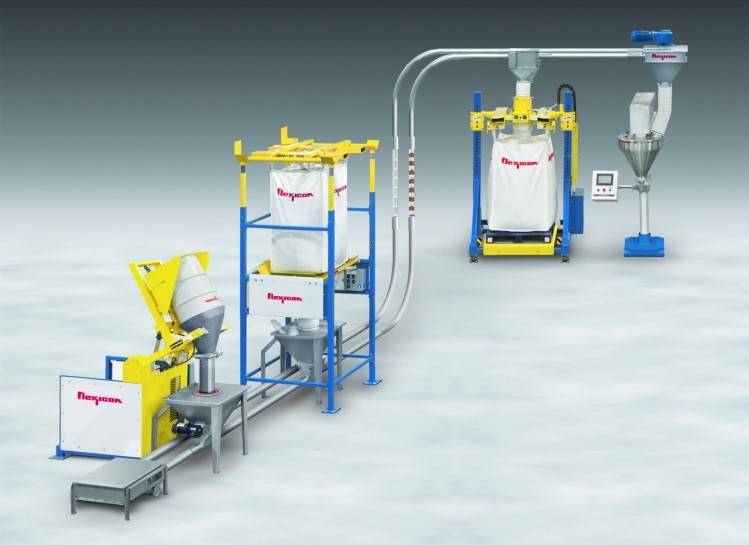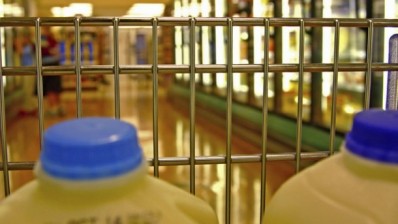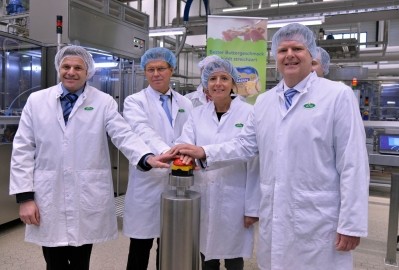Dry milk producer installs Flexicon bulk bag discharger for baked goods, ice cream & confectionery

The firm previously manually emptied 23kg bags of powdered ingredients from suppliers into its ribbon blender, creating dust and wasted product.
Transfer and blending remain enclosed & dust-free
The company installed the bulk bag discharger and bag dump station and flexible screw conveyors to transport the ingredients to the blender. The transfer and blending area now remain enclosed and dust-free.
Jonathan Riggs, vice president, production, FFE, told DairyReporter, it is running the blender at full capacity but plans to expand the room to increase production with a larger blender and raise the ceiling.
It also wants to expand its product range including instant cheesecake mix.
“Headroom in the dry blending room is currently limited by the low ceiling. To overcome this, a forklift holds the bulk bag directly over the lower half of the split frame discharger, while the bag discharges through a manual Spout-Lock clamp ring positioned atop a pneumatically-actuated Tele-Tube telescoping tube,” he said.
“The tube raises the clamp ring for dust tight connection to the bag spout, and then lowers, applying downward tension to keep the spout taut for total evacuation. At the same time, Flow-Flexer bag activators raise and lower the bottom edges of the bag, directing material into the outlet spout and raising the bag into a steep "V" shape to promote total discharge into the floor hopper.”
FFE was founded in 1983 as a distributor of dry milk products, which it purchased in bulk from dairy cooperatives and other wholesalers. It then hired contract manufacturers to blend and repackage the final mixes, which it sold to customers ranging from “Mom and Pop” operations to high volume commercial bakeries, ice cream producers and confectionery firms.
The dry blending room was developed by John Oliveira of PME Equipment, an independent representative located in Flanders, New Jersey.
Non-dairy coffee creamers & lactose-free products
“Our nonfat dry milk is a wholesome dairy product made from the freshest liquid milk,” added Riggs.
“Only the cream and water are removed. It still contains all the calcium and other minerals, vitamins, natural sugar and proteins that make liquid milk a valuable food but it is easier to work with, does not need to be refrigerated, has a longer shelf life than fluid milk, and takes less inventory space.”
As the business grew, the company built its own processing and repackaging facility, in Frostburg, Maryland. With its own in-house blending capabilities, it expanded its product line beyond dairy products like buttermilk and whey to include formulations based on corn and wheat flour, such as non-dairy coffee creamers and lactose-free products.
Since then, sales have grown from 20,000 kg per month to over 454,000 kg per month and the firm has expanded into new markets such as ice cream mixes, gelato and yoghurt.
The plant runs two shifts a day, five days a week, with a crew of 12 people.
The Flexicon system consists of a forklift-loaded model BFF-C-X split-frame Bulk-Out bulk bag discharger, with a 226 l-capacity sanitary stainless steel hopper, and a manual bag dump station, bag compactor and hopper for adding smaller amounts of ingredients to the blender.
“The ingredient discharge, blending and repackaging process is now totally enclosed and dust-free,” said Riggs.
High-velocity vacuum fan
Minor ingredients, in 23kg bags, are transferred to the batch blender through a manual bag dump station, hopper and flexible screw conveyor.
A high-velocity vacuum fan activates as the operator opens the hinged lid of the bag dump station. As individual bags are emptied through the hopper screen, airborne dust in the hopper opening is drawn into the dust collector and deposited on the outer surfaces of two cartridge filters.
Periodic blasts of compressed plant air blown onto the filters dislodge the dust particles, which fall into the hopper. The process is continuous with compressed air blasts alternating between the two filters.
The operator passes the spent bag through a chute in the sidewall of the hopper hood into the bag compactor.
One blended batch, weighing 1,134kg, usually consumes one bulk bag and as many as 25, 23kg bags of individual ingredients. Each batch requires about 10 minutes for mixing, and the blender can produce 30 to 40 batches per day.
The blended batch proceeds through a screener, a metal detector, and then to the bagging machine, which fills 11.4 to 23kg bags, at a rate of one bag per minute, and labels them with the name of the blend. The bags are finally loaded onto shipping pallets.
The system is cleaned according to FDA procedures by brushing, vacuuming and hot washing of product contact surfaces of the screener, hoppers, flexible screw conveyors, and blender.














